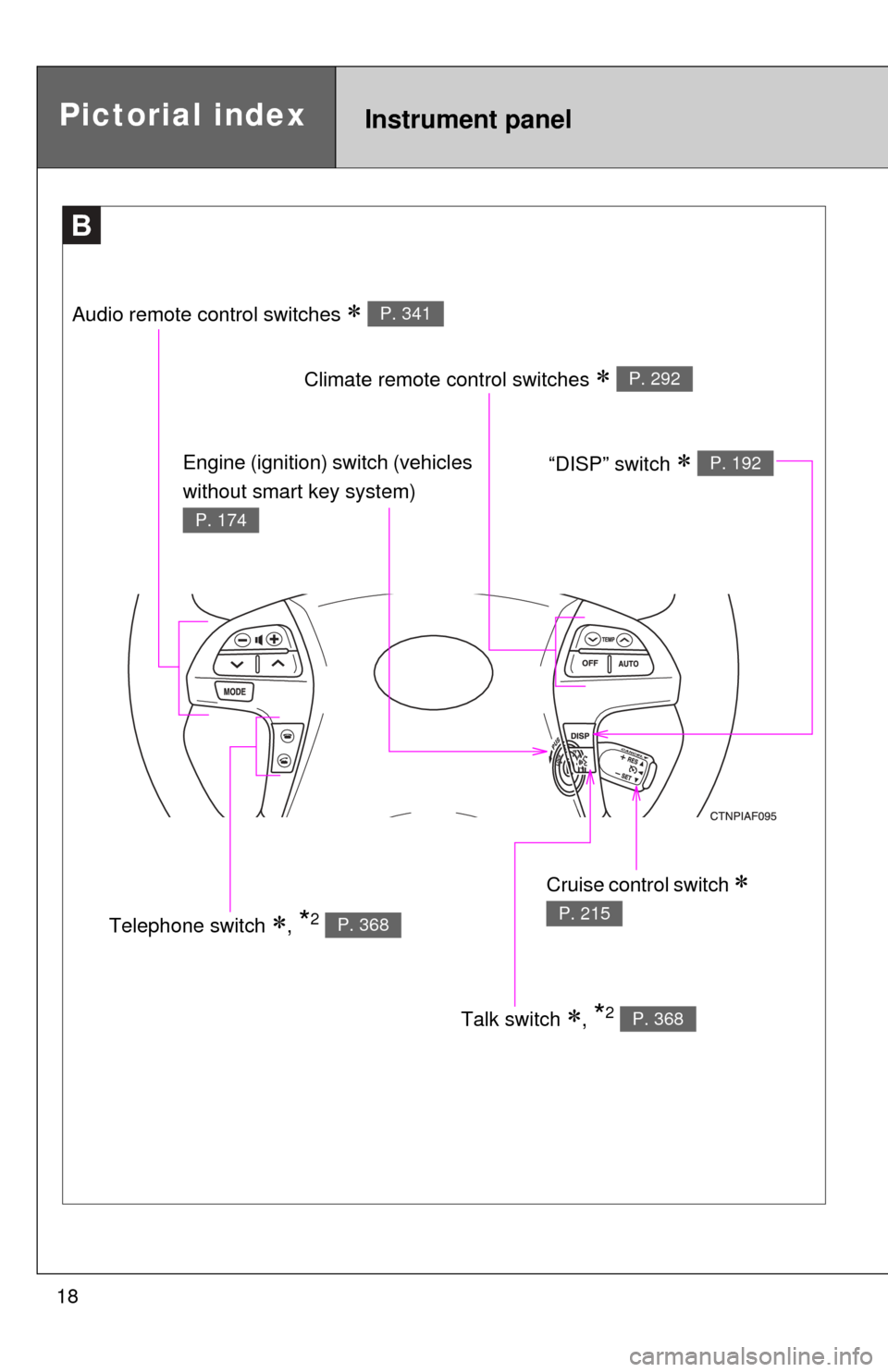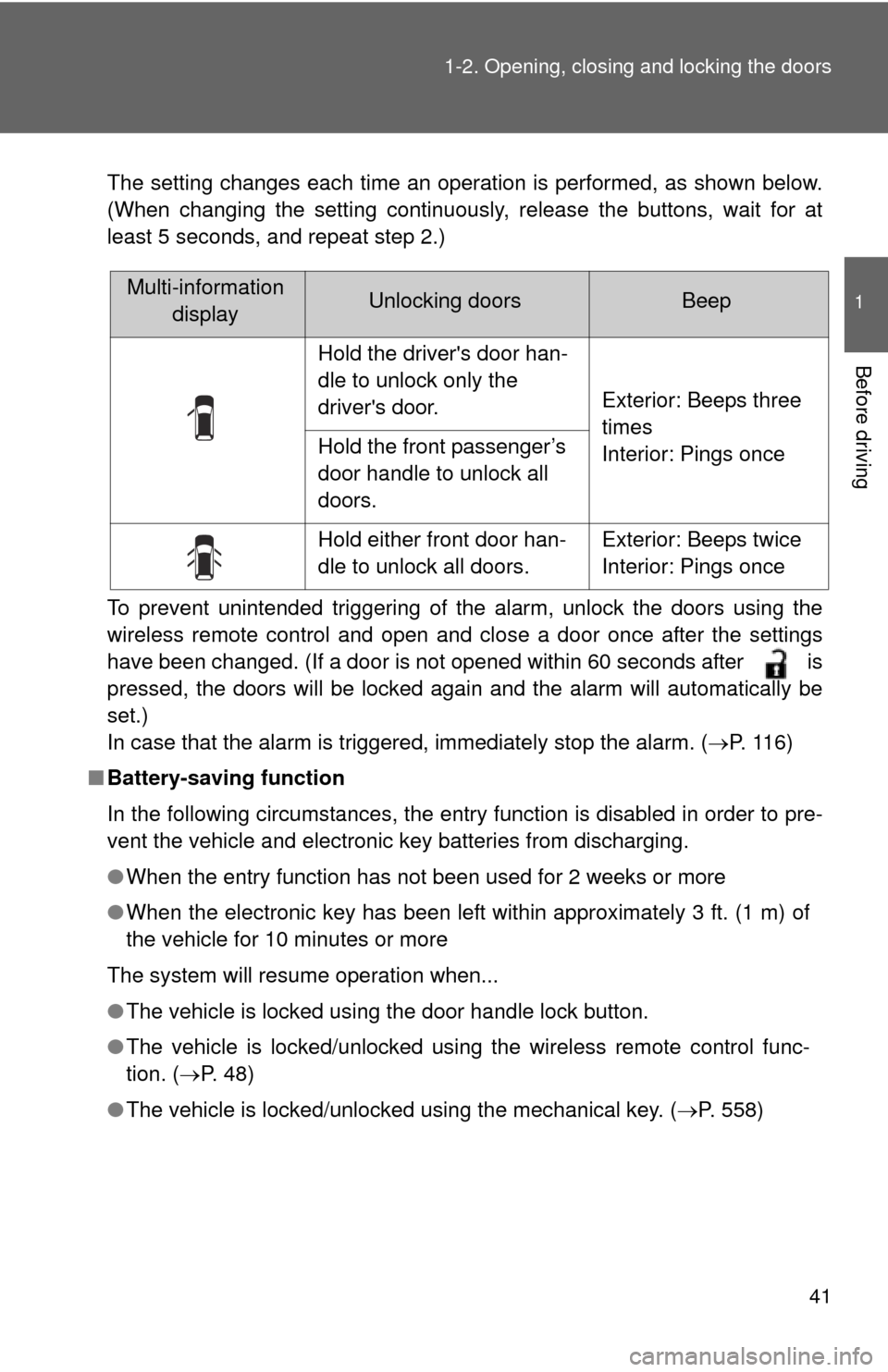remote control TOYOTA HIGHLANDER 2012 XU40 / 2.G Owners Manual
[x] Cancel search | Manufacturer: TOYOTA, Model Year: 2012, Model line: HIGHLANDER, Model: TOYOTA HIGHLANDER 2012 XU40 / 2.GPages: 636, PDF Size: 11.24 MB
Page 2 of 636

TABLE OF CONTENTSIndex
2
1-1. Key informationKeys ..................................... 32
1-2. Opening, closing and locking the doors
Smart key system................. 35
Wireless remote control ....... 48
Side doors ............................ 54
Back door ............................. 60
Glass hatch .......................... 70
1-3. Adjustable components (seats, mirrors,
steering wheel)
Front seats ........................... 74
Rear seats ............................ 77
Head restraints ..................... 85
Seat belts ............................. 88
Steering wheel ..................... 94
Anti-glare inside rear view mirror.......................... 95
Outside rear view mirrors ..... 98
1-4. Opening and closing the windows and moon roof
Power windows .................. 101
Moon roof ........................... 104
1-5. Refueling Opening the fuel tank cap ................................... 109 1-6. Theft deterrent system
Engine immobilizer system .............................. 113
Alarm .................................. 116
Theft prevention labels (U.S.A.)............................. 120
1-7. Safety information Correct driving posture ....... 121
SRS airbags ....................... 123
Front passenger occupant classification system ......... 135
Child restraint systems ....... 142
Installing child restraints ..... 147
2-1. Driving procedures Driving the vehicle .............. 160
Engine (ignition) switch (vehicles with smart
key system) ...................... 170
Engine (ignition) switch (vehicles without smart
key system) ...................... 174
Automatic transmission ...... 177
Turn signal lever ................. 182
Parking brake ..................... 183
Horn .................................... 184
2-2. Instrument cluster Gauges and meters ............ 185
Indicators and warning lights ................................. 187
Multi-information display ..... 191
1Before driving
2When driving
Page 3 of 636

1
2
3
4
5
6
7
3
2-3. Operating the lights and wipers
Headlight switch .................. 200
Fog light switch ................... 206
Windshield wipers and washer .............................. 208
Rear window wiper and washer .............................. 212
2-4. Using other driving systems
Cruise control ...................... 215
Rear view monitor system .............................. 219
Driving assist systems ........ 223
Hill-start assist control ......... 228
Downhill assist control system (4WD models) ...... 230
2-5. Driving information Off-road precautions ........... 233
Cargo and luggage ............. 238
Vehicle load limits ............... 242
Winter driving tips ............... 243
Trailer towing ...................... 247
Dinghy towing ..................... 265 3-1. Using the air conditioning
system and defogger
Front manual air conditioning system.......... 268
Front automatic air conditioning system.......... 275
Rear manual air conditioning system.......... 283
Rear automatic air conditioning system.......... 286
Rear window and outside rear view
mirror defoggers ............... 289
Windshield wiper de-icer .... 291
Using the steering wheel climate remote control
switches ........................... 292
3-2. Using the audio system Audio system ...................... 293
Using the radio ................... 297
Using the CD player ........... 304
Playing back MP3 and WMA discs ....................... 312
Operating an iPod .............. 320
Operating a USB memory ............................ 327
Optimal use of the audio system .............................. 335
Using the AUX port............. 339
Using the steering wheel audio switches.................. 341
Detachable pole antenna ............................ 344
3Interior features
Page 5 of 636

1
2
3
4
5
6
7
5
4-1. Maintenance and careCleaning and protecting the vehicle exterior............ 440
Cleaning and protecting the vehicle interior............. 443
4-2. Maintenance Maintenance requirements ..................... 446
General maintenance.......... 449
Emission inspection and maintenance (I/M)
programs........................... 452
4-3. Do-it-yourself maintenance Do-it-yourself service precautions ....................... 453
Hood ................................... 457
Positioning a floor jack ........ 459
Engine compartment ........... 463
Tires .................................... 478
Tire inflation pressure ......... 487
Wheels ................................ 490
Air conditioning filter............ 493
Wireless remote control/ electronic key battery ........ 496
Checking and replacing fuses ................................. 499
Light bulbs........................... 510 5-1. Essential information
Emergency flashers............ 518
If your vehicle needs to be towed........................... 519
If you think something is wrong ............................ 526
Fuel pump shut off system .............................. 527
5-2. Steps to take in an emergency
If a warning light turns on or a warning buzzer
sounds... .......................... 528
If a warning message is displayed .......................... 539
If you have a flat tire ........... 540
If the engine will not start.... 554
If the shift lever cannot be shifted from P ................... 556
If you lose your keys/ wireless remote control
transmitter ........................ 557
If the electronic key does not operate properly ......... 558
If the battery is discharged........................ 560
If your vehicle overheats .... 564
4Maintenance and care5When trouble arises
Page 18 of 636

18
B
Talk switch , *2 P. 368
Pictorial indexInstrument panel
Audio remote control switches P. 341
Climate remote control switches P. 292
Cruise control switch
P. 215Telephone switch , *2 P. 368
Engine (ignition) switch (vehicles
without smart key system)
P. 174
“DISP” switch P. 192
Page 25 of 636

25
Installation of a mobile two-way radio system
The installation of a mobile two-way radio system in your vehicle could affect
electronic systems such as:
●Multiport fuel injection system/sequential multiport fuel injection system
●Cruise control system
●Anti-lock brake system
●SRS airbag system
●Seat belt pretensioner system
Be sure to check with your Toyota dealer for precautionary measures or spe-
cial instructions regarding installation of a mobile two-way radio system.
Scrapping of your Toyota
The SRS airbag and seat belt pretensioner devices in your Toyota contain
explosive chemicals. If the vehicle is scrapped with the airbags and seat belt
pretensioners left as they are, this may cause an accident such as fire. Be
sure to have the systems of the SRS airbag and seat belt pretensioner
removed and disposed of by a qualified service shop or by your Toyota
dealer before you scrap your vehicle.
Perchlorate Material
Special handling may apply, See www.dtsc.ca.gov/hazardouswaste/perchlorate.
Your vehicle has components that may contain perchlorate. These compo-
nents may include airbag, seat belt pretensioners, and wireless remote con-
trol batteries.
Page 31 of 636

Before driving1
31
1-1. Key informationKeys ................................... 32
1-2. Opening, closing and locking the doors
Smart key system .............. 35
Wireless remote control ..... 48
Side doors .......................... 54
Back door ........................... 60
Glass hatch ........................ 70
1-3. Adjustable components (seats, mirrors,
steering wheel)
Front seats ......................... 74
Rear seats.......................... 77
Head restraints................... 85
Seat belts ........................... 88
Steering wheel ................... 94
Anti-glare inside rear view mirror ....................... 95
Outside rear view mirrors.............................. 98 1-4. Opening and closing the
windows and moon roof
Power windows ................ 101
Moon roof ......................... 104
1-5. Refueling Opening the fuel tank cap ................................. 109
1-6. Theft deterrent system Engine immobilizer system ........................... 113
Alarm................................ 116
Theft prevention labels (U.S.A.) .......................... 120
1-7. Safety information Correct driving posture..... 121
SRS airbags ..................... 123
Front passenger occupant classification system ...... 135
Child restraint systems..... 142
Installing child restraints ........................ 147
Page 32 of 636

32
1-1. Key information
Keys
The following keys are provided with the vehicle.
Vehicles without smart key system (type A)
Master keys
Va l e t k e y
Key number plate
Vehicles without smar t key system (type B)
Master keys
Va l e t k e y
Key number plate
Vehicles with smart key system Electronic keys
• Operating the smart keysystem ( P. 35)
• Operating the wireless
remote control function
( P. 48)
Mechanical keys
Key number plate
Page 40 of 636

40 1-2. Opening, closing and locking the doors
■Operation signals
A buzzer sounds and the emergency flashers flash to indicate that the doors
have been locked/unlocked. (Locked: Once; Unlocked: Twice)
■ Conditions affecting operation
The smart key system uses weak radio waves. In the following situations,
the communication between the electronic key and the vehicle may be
affected, preventing the smart key system and wireless remote control from
operating properly. (Ways of coping: P. 558)
● When the electronic key battery is depleted
● Near a TV tower, electric power plant, gas station, radio station, large dis-
play, airport or other facility that generates strong radio waves or electri-
cal noise
● When carrying a portable radio, ce llular phone, cordless phone or other
wireless communication devices
● When the electronic key is in contact with, or is covered by a metallic
object
● When multiple electronic keys are in the vicinity
● When carrying or using the electronic key together with the following
devices that emit radio waves
• Another vehicle’s electronic key
• A wireless key that emits radio waves
• Personal computer
● If window tint with a metallic content or metallic objects are attached to
the rear window
■ Switching the door unlock function
It is possible to set which doors the entry function unlocks.
Turn the “ENGINE START STOP” switch OFF.
When the indicator on the key surface is turned off, push and hold
, or for approximately 5 seconds while pushing
on the key.
STEP1
STEP2
Page 41 of 636

41
1-2. Opening, closing and locking the doors
1
Before driving
The setting changes each time an operation is performed, as shown below.
(When changing the setting continuously, release the buttons, wait for at
least 5 seconds, and repeat step 2.)
To prevent unintended triggering of the alarm, unlock the doors using the
wireless remote control and open and close a door once after the settings
have been changed. (If a door is not opened within 60 seconds after is
pressed, the doors will be locked again and the alarm will automatically be
set.)
In case that the alarm is triggered, immediately stop the alarm. (P. 1 1 6 )
■ Battery-saving function
In the following circumstances, the entry function is disabled in order to pre-
vent the vehicle and electronic key batteries from discharging.
●When the entry function has not been used for 2 weeks or more
● When the electronic key has been left within approximately 3 ft. (1 m) of
the vehicle for 10 minutes or more
The system will resume operation when...
● The vehicle is locked using the door handle lock button.
● The vehicle is locked/unlocked using the wireless remote control func-
tion. ( P. 48)
● The vehicle is locked/unlocked using the mechanical key. ( P. 558)
Multi-information
displayUnlocking doorsBeep
Hold the driver's door han-
dle to unlock only the
driver's door.
Exterior: Beeps three
times
Interior: Pings once
Hold the front passenger’s
door handle to unlock all
doors.
Hold either front door han-
dle to unlock all doors.Exterior: Beeps twice
Interior: Pings once
Page 42 of 636

42 1-2. Opening, closing and locking the doors
■Electronic key battery depletion
●The standard battery life is 1 to 2 years. (The battery becomes depleted
even if the electronic key is not used.) If the smart key system or the
wireless remote control function does not operate, or the detection area
becomes smaller, the battery may be depleted. Replace the battery when
necessary. ( P. 497)
● If the battery becomes low, an alarm will sound in the cabin when the
engine stops. ( P. 43)
● To avoid serious deterioration, do not leave the electronic key within 3 ft.
(1 m) of the following electrical appliances that produce a magnetic field.
•TVs
• Personal computers
• Recharging cellular phones or cordless phones
• Table lamps
■ To operate the system properly
Make sure to carry the electronic key when operating the system. Do not get
the electronic key too close to the vehicle when operating the system from
the outside of the vehicle.
Depending on the position and holding condition of the electronic key, the
key may not be detected correctly and the system may not operate properly.
(The alarm may go off accidentally, or the door lock prevention may not func-
tion.)
■ Note for the entry function
●Even when the electronic key is within the effective range (detection
areas), the system may not operate properly in the following cases.
• The electronic key is too close to the window or outside door handle,
near the ground, or in a high place when the doors are locked or
unlocked.
• The electronic key is on the instrument panel, luggage cover, floor or in the glove box when the engine is started or “ENGINE START STOP”
switch modes are changed.
● Do not leave the electronic key on top of the instrument panel or near the
door pockets when exiting the vehicle. Depending on the radio wave
reception conditions, it may be detected by the antenna outside the cabin
and the door will become lockable from the outside, possibly trapping the
electronic key inside the vehicle.